By Gregory Sellers
In this day and age of the fire service with short-staffing and greater emphasis on fireground support tasks to improve firefighter safety and survivability, the truck driver has far more tasks to complete than “just getting the rig to the scene and setting the stick.” This position is typically held by a firefighter with some seniority who has been the company officer’s “right-hand” person and has proven himself on the fireground.
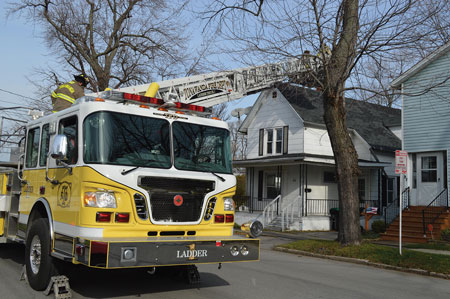 |
| (1) When approaching the scene, be aware of trees that may hamper placement of the aerial. Also position apparatus out of the collapse zone. (Photos by Don Murtha III). |
When many departments operate with just three firefighters per apparatus, the driver must be able to operate effectively and efficiently alone and with little direction from the company officer. The driver must complete many exterior fireground tasks including setting up egress ladders, checking utilities, and performing horizontal ventilation, to name a few. This article discusses tasks the truck company driver must perform and tips on how to perform them. As always, your department’s standard operating procedures (SOPs) should dictate the tasks for which each truck driver is responsible.
Preparation/Response
For any seat assignment, preincident preparation is key; the truck driver must check off the apparatus in accordance with the department’s standard practice. The apparatus check-off should include the driver’s regularly checking the oil, the transmission fluid, and the antifreeze and bleeding the air brakes even if automatic bleeders are present.
The following should also be completed daily:
- Engage the power take-off.
- Operate the outriggers, aerial, or platform from both pedestal and boom/bucket controls.
- Check nozzle functions to include the pinnable waterway. Many drivers keep the nozzle in the “rescue mode,” since an aerial is used for access 95 percent of the time.
- Run the generator, and put it under load using onboard and portable lighting; walk around the apparatus, checking all emergency and nonemergency lights.
- Ensure that self-contained breathing apparatus have a full air supply.
- Ensure that hand tools and power saws are cleaned and properly functioning and have full fuel tanks.
- Ensure that the thermal imaging camera (TIC) has a full battery and flashlights are fully charged.
- Verify that the apparatus has a full fuel tank.
Neglecting to do any of these tasks can result in the operation’s slowing down or being left undone.
When an alarm is received, the driver should take the best possible route to the scene. If not sure of an address or a street location, the driver should check the map before the response. Most of the time, the truck will be positioned at the front of the structure, which usually is the best position for operations involving the aerial device and the equipment on the apparatus.
In commercial structure responses, the second-due truck, if possible, should attempt to gain access to the rear of the structure to provide rear access, roof access, and ventilation. In some situations, limited or no access or the structure’s size may prevent this. In some cases, it may be necessary to create access by cutting a fence or forcing locked gates.
When approaching the scene, the truck driver must be aware of the response routes of other apparatus. It may be necessary to go past the scene and come around the block to get in the proper position. Slow down when approaching the scene. Look for overhead wires and parked cars that may prevent you from setting the outriggers or accessing the fire location, victims, and exposures. When positioning the apparatus, you must put life-saving measures first; therefore, a victim’s location may predict where you initially set up the apparatus.
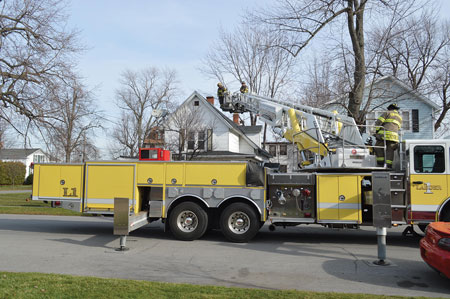 |
| (2) With aerial placement, covering two sides of the structure is ideal. Be aware of outrigger placement and obstacles such as vehicles, curbs, and sewer drains. |
Another practice when positioning the turntable is to place it at a corner of a structure so that it covers two sides of the structure; this is beneficial with a tower ladder or if the building is fully involved on arrival. It also prevents the likelihood that the apparatus will be struck by a collapse, since the corner is the strongest part of a building. If driving a tillered apparatus, use your tillerman to help you spot the turntable, whether by intercom or apparatus headsets. In rear-mount apparatus, use a landmark on the side of the apparatus you can see to spot the turntable.
Unfortunately, street conditions sometimes force us to short-jack the apparatus to get them into operation. Remember, if you need to short-jack an apparatus, you must get the outriggers fully extended on the operating side (fire side) to get the maximum use of the device. In many apparatus, the computers are preset to shut down or stop a specific function if the apparatus is not set up properly or the aerial is brought to an unsafe position. If it is a tillered apparatus, depending on the manufacturer, the outrigger must be extended enough to get the pin in place. Don’t hesitate to place outriggers between parked vehicles. Make sure to use wood cribbing to build up a flat surface if the outrigger pad will land on an uneven or soft surface.
Additionally, remember to leave room for the open compartment doors when you pull next to another vehicle. If your truck has an onboard generator, activate it prior to arriving on scene to provide scene lighting and power for interior lights or ventilation fans. Once you have arrived and properly placed your apparatus, as simple as it seems, you need to be in full personal protective equipment, as you will be operating continuously around the fire building.
360°/Utility Control/Entry
Once you arrive on scene, gather your personal tools, typically a six-foot hook and a halligan tool. One of the jobs of the truck is to gain entry to the structure, get to the front door, and assist with forcible entry if needed. Once you have gained entry, secure the door open with a door chock, webbing wrapped around an object, or a piece of furniture or other structure contents that are easy to place.
Next, conduct a 360° survey to get an idea of the building’s layout (identify windows to certain rooms, window placement for stair landings, setbacks and additions on buildings), ladder placement, secondary egress points, fire/smoke location, roof stability, and other factors that may affect the incident. Your position permits you to continuously operate around the structure, which makes you an excellent firefighter to notify the incident commander (IC) of any concerns throughout the incident. Anything you see that would be a concern, such as collapse potential, fire spread, or occupants hanging out of windows, must be relayed to the IC.
Throughout the incident, take several “laps” around the structure and report any significant findings. When completing your initial 360° assessment, secure the utilities (usually the gas and electric supply; water utilities are usually secured later in the incident as a property conservation concern).
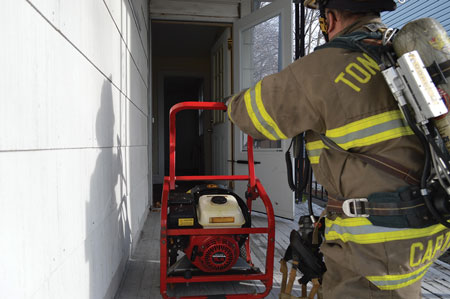 |
| (3) Place the positive-pressure ventilation fan the distance of the height of the door to obtain the proper “cone of air”; do not start the fan until ordered to do so, usually by the interior truck officer. |
Electric meters may be found anywhere on the exterior of residential structures, but they usually are on the exterior of garages or in utility rooms. Once you find the meter, the panel box will be within a couple of feet on the opposite side. In apartment complexes or commercial structures, multiple meters may be found together and will have the suite or apartment number marked on them. Generally, the panel box will not be on the other side. Those panel boxes will be in the apartment or suite number marked on the box. In older homes, the panel boxes may be found in closets, bedrooms, or kitchens. When getting to the panel box, if you’re able to, take a quick look and see if any breakers are tripped; make a mental note. Secure the breakers individually and then the master breaker. Once power is secured, notify the IC. If you are unable to get to the panel box, notify your officer as to its potential location so that your interior crew can secure power.
If you get to the meter at a working fire and the meter has a security ring with a lock on it, advise the IC to notify the power company to secure the power. Some departments approve pulling the meter; refer to your departmental SOP regarding this practice. You can also secure the gas meter; it is usually fairly simple-just a quarter turn of the valve coming from the ground supply. Once you get to the meter, look for the supply from the ground. It should have a quarter-turn valve on it. Turn the valve until it is 90° to the supply pipe and the lock holes are in line. Once you secure the gas, notify the IC. If you are unable to cut the gas supply, ask the IC to request the gas company.
After your 360° walk-around is complete, contact your officer, if applicable to your departmental SOP; there may be another task for you to complete. This may include shutting off the sprinkler system to structures equipped with a suppression system. You may have to access the basement, which in many older homes contains the electric, gas, and water cutoffs.
Ground Ladders
With the emphasis on rapid intervention and firefighter survivability, the ground ladder is one of your biggest allies. As a truck driver, you should get as many ground ladders to upper floors as possible. Initially, try to get a ground ladder to the fire area on upper floors. Your next ladder should be on the side closest to the fire area and then to the rest of the building. Use all of your ground ladders. If you need more ladders, take them off the engines on the scene. Remember, placement is key. The tip of the ladder must be even or just below the windowsill. If using the ladder for ventilation initially, take out the window with the tip. Then set your ladder correctly under the window. Climb up the ladder and finish taking the sash, glass, shades, and blinds with your six-foot hook or halligan. Remember, coordinate this with the interior crew. Don’t vent until your officer tells you to.
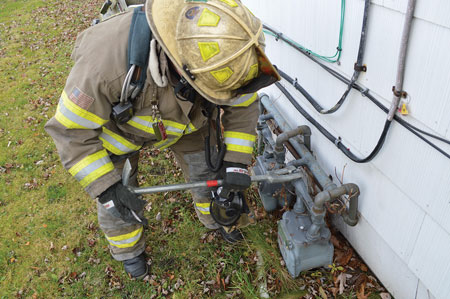 |
| (4) Securing utilities during your 360° walk-around will provide for a safer fireground operation. |
When placing ladders, place them at an angle less than the standard 75° climbing angle. This provides more of a slide in case members have to bail out of a window.
Once you have placed ladders, inform the IC that egress ladders are in place and where they are.
Attic access is key to a successful outcome of a structural fire incident. Place an attic ladder near the primary entrance for the interior crews. Also, if you need help, ask for an additional company to assist. The rapid intervention team, once on scene, should automatically assist, depending on department procedure.
Ventilation
Probably the most important job, not taking away from the other tasks, is ventilation. The truck driver is essentially the outside vent (OV) firefighter. The tools the driver should carry, as stated earlier, are the six-foot hook (steel preferably) and the halligan tool. Most incidents can be handled with the positive pressure ventilation (PPV) blower and a few opened windows or doors. When placing the PPV blower, place the fan back a distance equal to the height of the door. This is a good starting point to get your cone of air. Adjust the fan as needed. Make sure you have an exhaust portal opposite the fan. On working fires, completely remove windows in a coordinated fashion-sash, blinds, glass, curtains, and frame. This is not only a ventilation opening; it’s a means of egress. As stated, this is a very coordinated tactic. Don’t just “bust glass” or start the fan without direction. Wait for the order, or contact your officer or interior attack team to see if members are ready for the ventilation fan. Ventilate in the area of the fire initially, then vent as needed throughout the structure. You do not want to create a new flow path for fire spread or an unexpected rapid fire. Opening windows is great for customer service-less damage, good property conservation, and easy to secure.
Aerial Placement/Scene Lighting
As a driver, you must place the apparatus once; once lines are on the ground, it is very, very difficult to move an aerial apparatus into position for aerial use. When approaching the scene, whether it’s for an odor of smoke or a working fire, place the truck as if you’re going to use the aerial every time. This prevents having to move the truck later or getting another truck into position to do the aerial work. This also gets the driver into that “muscle memory” of aerial placement every time. When approaching the scene, remember overhead obstructions are usually going to be an issue; keep your aerial at least 10 feet from power lines.
Get the most scrub area (overall area of reach of the aerial) as possible; covering two sides of the structure is preferred. You want the aerial tip to reach the top of the roof or in the valley of the roof-this is where your primary vertical ventilation hole may be cut. If your aerial is equipped with a pinnable waterway, make sure you are aware of what position it is in (waterway/rescue). Most of your aerial operations are going to be for access or egress, so the nozzle usually should be pinned back one fly section.
For ladder pipe operations, make sure you pin your nozzle to the tip of the aerial to get the most reach of your ladder pipe stream. Make sure your nozzle is properly pinned. There have been instances where the nozzle was not pinned and the waterway was charged and both the nozzle and the waterway blew off the aerial, injuring and killing firefighters. Regarding outriggers, make sure that they are fully extended, pinned (if applicable), and firmly planted on solid ground.
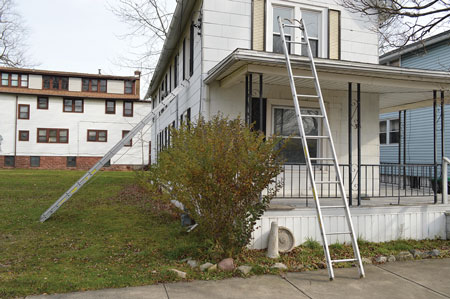 |
| (5) Position ground ladders for egress. Ideally, set them up closest to the fire area first. |
Aerials are now designed to be nonsupported aerial devices. This means that no part of the aerial can touch any part of the building, whether windows or roofline. Doing so will add undue stress or torsion to the aerial and may cause a catastrophic aerial failure. Also, be aware of prepiped waterways mounted under the aerial. Any damage to them will cause the aerial waterway or aerial to be placed out of service for an extended time. A good rule of thumb is to place the aerial six to 12 inches above the roof line, or the aerial will “bounce” when moving personnel up and down.
Do not overlook scene lighting; it is a very important safety task. When you pull into the scene, get the apparatus generator in operation and light the scene up with as many apparatus lights as you can. If you have portable lights, place them around the exterior of the structure, preferably at corners. Once the fire is knocked down, start running interior lights to as many floors as possible, using the truck generator and onboard electrical cords. This task is obviously done later in the incident, but it should be a priority because it makes the scene safer, especially at nighttime.
Taking Up/In Quarters
Once the incident is over, the apparatus must be made ready for the next job. Before you leave the scene, account for all of your equipment and any equipment you may have used from other apparatus. A good driver will conduct an “inventory” and do a final walk-around of the apparatus prior to leaving the scene. If you have spare air cylinders, fill them regardless of whether it’s from an on-scene air truck or you have to go someplace within the department to fill them. Once in quarters, clean the hand tools, place a new battery in the TIC, clean and fuel saws, clean and fuel PPV, place fresh portable batteries in radios, and fuel the apparatus. Some of these tasks depend on the length of the incident, but some must be done after every incident. If any equipment was left at the scene (salvage tarps, for example), document this information in a common spot in the watch office or apparatus, and make the next crew aware of it so they can be retrieved.
The job of truck driver, as you can see, is more than just being able to maneuver a large apparatus through streets. The driver must be skilled, confident, and proactive and be able to anticipate the needs of the incident. The driver must act independently while accomplishing many tasks and know when to get help if needed. The driver is responsible for the apparatus and everything on it, and his actions can set the tone for a successful incident for the truck company.
GREGORY SELLERS began his career in the fire service in 1992 in Tonawanda, New York. He is a 16-year veteran of the Chesapeake (VA) Fire Department and a lieutenant in the Smithfield (VA) Volunteer Fire Department. He is an instructor in truck company operations and has been assigned to truck companies for most of his career.
DRIVER TRAINING PROGRAM INCREASES EXPERTISE AND SAFETY
Simulation: The Next Step in Driver Training
CREATING AN APPARATUS DRIVER RESPONSE SOP
Fire Engineering Archives

